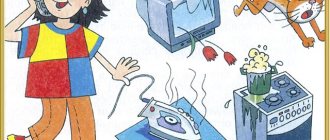Are there any rules of behavior for children on public transport? The question is far from idle. Firstly, any transport is a zone of increased danger for any person, and even more so for a child. And secondly, many children absolutely do not know how to behave in transport. They run, jump, make noise, climb onto seats in their shoes, it happens that they paint the interiors of buses and trolleybuses with all sorts of designs, break and even cut chairs with knives... A familiar picture, isn’t it? And the most important and terrible thing is that young passengers often endanger their lives and even the lives of other passengers.
Alas, there are no rules specifically written for children on how they should behave on public transport. There are approved rules for all passengers in general, regardless of age. But, of course, children are not interested in them. And therefore, parents need to further explain to their young brats how they should behave on trams, trolleybuses, buses and other types of public transport. Let's talk about this in more detail.
Safe behavior of children in public transport
Note to parents: if you don’t explain something to your child, he simply won’t know it. Many obvious postulates that are relevant for adults are not so unshakable for children. The solution is simple - before sending a child somewhere unaccompanied by parents, you need to talk to him about what safety rules exist in transport for children.
Among them are the following:
- Don't get too close to the road. Standing on the curb is also not recommended, especially in icy conditions.
- It is necessary to evaluate the trajectory of the vehicle, monitor its direction while reducing speed and approaching a stop.
- People enter public transport holding the handrail.
- If the child is under 7 years old, a parent must hold his hand. The baby holds on to the handrail with his other hand.
- You can't stop near the doors.
- You need to hold on to one of the available handrails until you can sit down.
- It is prohibited to stick your arms and head out of open vehicle windows.
Please note that a child can be placed on public transport unaccompanied by an adult if he has reached the age of 7 years. It is not recommended to do this before. Prepare your child in advance for such an important process.
Travel after the age of seven is paid in full. Depending on the pricing features in the region, the price may vary. Also, in some localities and on a number of routes, there are separate rules that provide for the possibility of a child traveling at a partial price (with a discount), for example, during school hours.
From about 3-4 years old, parents should explain to children how they get to certain places. Children are taught safety rules from the same age. The child must clearly understand that he is going somewhere with his mother, father or another adult. The purpose of this is to get to a point in a city, region, or country as a whole located at a great distance from the current location.
On short routes you need to pay special attention. Tell your child why the minibus, bus or trolleybus stops. List the names of the streets, explain why we are now driving along Pushkin Street, and in a couple of minutes it will already be Svobody Avenue. Learn to distinguish between “left” and “right” and understand the essence of turns. By the age of 6, children should clearly imagine in their imagination the most frequent routes, guided by the names of stops and identification signs, places that they remember.
Photo source: https://www.shutterstock.com/
Fines for passengers in 2022
The Code of Administrative Offenses provides for 2 options for fines for passengers:
- Article 12.29, part 1 – warning or 500 rubles. Imposed for any violation of the rules that did not interfere with other road users. For example, such a fine threatens a passenger who does not wear a seat belt.
- Article 12.30 part 1 – 1,000 rubles. Imposed if the passenger interferes with the movement of vehicles. For example, he was not convinced that there were no cars and opened the car door from the side of the roadway.
This concludes the review of the rules for passengers.
Sources
- https://vospitanie.guru/povedenie/v-transporte
- https://etiketclub.ru/etiket-v-transporte
- https://www.tutu.ru/2read/bus/bus_rules/
- https://vplate.ru/etiket/pravila-povedeniya-v-obshchestvennom-transporte/
- https://fireman.club/statyi-polzovateley/pravila-bezopasnosti-v-obshhestvennom-transporte/
- https://pddmaster.ru/pdd/passazhir-pdd.html
Child on the subway
The metro is free for children under 7 years of age. In this case, a separate seat is not provided - the baby is in the arms of an adult who accompanies him.
Safety of children in public transport on escalators:
- hold on to the handrail;
- be on the right side;
- stand facing the direction of movement;
- do not touch immovable parts.
It is recommended to carry children under 7 years of age when using the escalator.
The following rules apply on the platform:
- it is forbidden to go beyond the boundary line (you need to show the child what it looks like);
- it is necessary to free up space so that passengers can get out;
- It is allowed to enter the carriage after passengers wishing to leave the carriage have done so (when explaining this to the child, emphasis should be placed on this).
If the child is under 7 years old, he or she must be held by the hand on the platform.
Child safety rules for parents in subway cars:
- you cannot lean against the door of the carriage;
- you need to hold on to the handrail;
- prepare for departure in advance;
- After the announcement of the door closing, disembarkation and embarkation should be stopped.
Explain to children where handrails are convenient for them. You should also display a passenger-to-driver device that can be activated to provide communication in the event of an emergency.
Railway transport
Train with passenger cars
When ensuring safety in public transport such as a train, you should adhere to the following recommendations:
- It is better to buy seats in cars located in the center of the train rather than in the “head” or “tail”. This is explained by the fact that the central part of the train will be least likely to be damaged in a collision.
- Give preference to places that are located opposite to the movement of the train.
- Find out in advance where emergency exits are located. Usually there are 2 of them per car.
- If your fellow travelers look suspicious or do not inspire confidence in you, it is better not to turn off the light in the compartment and try not to fall asleep.
- When traveling in a coupe, never leave the door half open. This will give other passengers unnecessary information.
- Keep all important documents and valuables close to you at all times. When you go to bed, place them under your pillow.
- Do not drink alcohol in the company of unfamiliar people. This dulls vigilance.
Actions in case of a railway accident
It is prohibited while the vehicle is moving to try to open the doors of the carriage, stand on the steps or lean out of open windows.
- The stop valve should only be used in very serious situations. If this occurs, it is not recommended to stop the train in places where it will be difficult to evacuate people (tunnel, bridge).
- Your luggage should not contain flammable items, toxic or chemical substances.
- If you smell burning or strange smoke, you should immediately inform the conductor about it.
When braking sharply, firmly grasp the handrails and rest your feet on the seat or wall to stabilize your body. It is better to lie down on the floor of the cabin. After waiting out one blow, you should not change position; subsequent blows, stronger ones, are possible. Only when it becomes clear that the train has finally stopped can you get up.
It is necessary to immediately leave the train cabin, because there is a high risk of fire. If you decide to leave the car through the emergency window, then do it on the left side, i.e. where there are no railway tracks.
Child on a bus and trolleybus
Rules for the safety of children on public transport (bus, trolleybus) can be combined into the following simple guide:
- Before boarding, you need to wait until people wishing to leave the vehicle get off. To do this, the passage is cleared.
- There is no need to linger at the door - people are walking behind, and the child must remember this.
- You should not smear the seat or other objects with your feet - your feet should always be tilted downwards.
- They don't eat on transport. This is especially true for cakes, ice cream, pies, etc. Limit your consumption of drinks - during the trip you can be harmful to your health.
- Noise is not the best travel companion. Explain to your child that shouting and talking loudly is prohibited.
- Show how to hold on to the handrails to avoid falling. The support must be maintained until the vehicle stops. Then you can release the handrail to get out. During the exit, it is also recommended to hold on.
As already noted, up to the age of 7, in transport, the parent holds the child in his arms. There are several such places on trolleybuses and buses. The quantity may depend on the capacity of the transport. As a rule, the first two are intended for disabled people, passengers with children, elderly people and pregnant women. They are located behind the driver.
Don’t forget to teach your child to treat other people politely and to give way to representatives of the categories of citizens listed above.
Where should seat belts be? All buses that transport passengers intercity are equipped with seat belts.
Should a child seat be provided for infants? Similar to the rule described above, an accompanying rule has been introduced. In accordance with it, buses that provide intercity transportation services (a route of more than 50 km are considered as such) must have separate seats for transporting passengers aged 0 to 12 years. Child restraints look like special seats equipped with seat belts.
Photo source: https://www.shutterstock.com/
You cannot eat ice cream or cake on transport.
It is necessary to explain to children that transport is not a canteen. Firstly, it is not hygienic. There are a lot of bacteria around, many hands touch the handrails and there is a high probability of intestinal diseases. Secondly, you can dirty innocent people. You can also make up a fairy tale on the fly about a baby elephant (or a bear cub, it doesn’t matter) who was eating ice cream in a trolleybus; it began to melt and drip directly onto the passengers standing nearby. Another point is that the driver can brake if necessary, and all the contents have a high risk of falling out on a nearby sitting or standing neighbor. It would also be useful to remind you that you should not throw candy wrappers. We must try to convey to the child that it is clean where there is no litter! These are the rules!
What to do in case of fire or accident
To ensure that the safety of children in transport is maintained even in difficult emergency conditions, they need to be familiarized with a set of basic rules, including the following:
- You need to be in the middle of the cabin - this increases the chance of avoiding damage in the event of an accident.
- Seated places are the safest. If a child notices that there are live objects in the cabin, they should not touch anything with their hands or other parts of the body. You need to go outside as quickly as possible while remaining calm.
- If passengers begin to panic due to an accident or fire, a stampede may occur. The solution to the problem is to use the emergency exit by tearing out the cord and pushing out the glass (sometimes a button is installed instead of the cord).
- If a fire occurs, you must leave the cabin. If this cannot be done, you should evaluate your location. Once the fire extinguisher is nearby, the equipment is removed and used to extinguish the fire.
- If a bus or trolleybus falls into the water, you need to wait until it is half filled with water. Next, the child dives and swims to the exit, crosses it, and swims out.
- In the event of a fire, you need to call 112, and also notify the driver if this has not been done previously.
- In any difficult situation, you can use the button to open the door in an emergency and provide free access to the exit.
Explain to your child that in the event of an accident or fire, you need to remain calm. Panic and slowness are extremely undesirable. Decisions and actions must be consistent and balanced - in this case, you can trust your child to use public transport independently. Safety and transportation of children are regulated by basic rules, and this applies not only to the metro, but also to trolleybuses. Tell your children about the possible consequences of their violations, give practical advice while on the bus with them.
Safety regulations
Rules of safe behavior must be followed in all situations. They were invented in order to preserve the health of a person who uses a bus, tram, train or plane. They apply to both adults and children, especially schoolchildren, who can independently use various transport services without parental accompaniment. Let's look at the main ones.
Memo: Rules for boarding and disembarking
- It is necessary to wait for the vehicle only at a specially equipped stopping point (stop);
- You should approach the entrance doors of a bus or train only after a complete stop; it is forbidden to jump into open doors while moving;
- If you notice that a bus or trolleybus is crowded, it is better to wait for the next one;
- Before entering a bus or other vehicle, you must let all exiting passengers pass;
- You should enter slowly, respecting the order, without trying to get ahead of everyone;
- After boarding, do not stop at the very entrance (unless you have to get off at the nearest stop), calmly walk to the middle, leaving space for those who enter after;
- There is no need to try to get off the bus or trolleybus first - it is best to wait until the main crowd of passengers leaves;
- It is advisable to cross the street after disembarking after the vehicle has left the stop;
- When boarding a tram, you must always go around it from the front, a bus or trolleybus - from the back.
Rules of behavior in nature for preschoolers
Memo: Rules for safe behavior on the road
When traveling, you should always behave with dignity and adhere to some safety rules and etiquette.
Main safety rules:
- You must not make noise, push, or cause other inconvenience to passengers;
- The transportation of flammable, flammable substances and sharp objects is prohibited in any transport. Large items (bags, backpacks) are best placed where they will not interfere with other passengers;
- The driver must not be distracted while he is working;
- It is necessary to hold on to special belts and handrails;
- In transport, it is better to stand facing to the side in the direction of travel or half-turn. You should not stop near the doors, much less lean out of the windows while moving or the doors when starting to move;
- Pets are transported in special cages and carriers; dogs are muzzled.
Memo: Rules of behavior on the bus (trolleybus) during the trip
When traveling on any transport, you must be polite to other passengers and follow the following rules:
- When entering, you need to take off your bags and backpacks so as not to touch other passengers or get them dirty;
- On the bus they don’t shake the snow off their clothes or the raindrops;
- According to generally accepted rules of behavior when boarding any transport, the first to enter are always the elderly, pregnant women, and the disabled. It is to them that schoolchildren must yield. The same must be done when leaving a public vehicle;
- It is advisable to prepare for the exit in advance (especially if there are a lot of passengers). Ask those in front: “Are you getting off at the stop?” Apologizing, ask permission to pass, and not push, silently making a way for yourself with your elbows;
- In the cabin it is necessary to give up seats to the elderly, women with small children, with heavy bags, and the disabled;
- In transport you should not push, try not to step on feet, do not lean your elbows on the person who is nearby, do not push him;
- In the cabin of a bus, trolleybus, tram they do not talk very loudly, do not lean out of the window, do not disturb passengers when exiting or entering;
- It is necessary to pay for the trip and, if necessary, show the coupon or ticket to the controller, the conductor, after the trip, the ticket is thrown into the trash bin;
- If you use a travel document, you need to keep it ready when boarding so as not to waste the conductor’s time and not cause inconvenience to other passengers when searching for it;
- If it’s uncomfortable to hold on in a crowded cabin, and you’re holding flowers or a cake, then don’t be shy and ask passengers to hold them;
- It is not customary to look closely at passengers, lean on them, or look into the phone or book of the person sitting or standing next to them;
- You cannot be rude to other passengers. If a remark is made about something, you should take note of it and try to improve;
- You cannot dirty the seats, climb on them with your feet, paint them, eat ice cream, cakes, comb your hair, clean your nails, laugh loudly, talk, discuss problems publicly, and much more.
Safe behavior of the child at home, in the apartment and in the entrance
Bottom line
It is very important to familiarize children with the rules for traveling on public transport in advance, long before the moment when parents can let the child “travel” around the city on their own.
Adults also do not need to forget about the rules for transporting small children, hold their hands, and monitor their safety. This is especially true for traveling on the subway and crossing intercity routes. Please note that his behavior in transport depends on how careful you are and how succinctly and clearly you can present information to your baby.
Rules of conduct on water transport
When traveling on water transport, accompanying persons must closely monitor the pupils. Children should be given a reminder about what they are prohibited from doing on board the ship:
- independently enter or disembark the vessel;
- be on the site without a protective fence;
- enter technical and office premises;
- carry flammable substances with you;
- hang over the ship's railing.
Important! If an evacuation has been announced, the accompanying person must gather the children, calm them down and take them to the lifeboats.
Each boat carrying a minor must have two adults. You can take only the most necessary things into the boat. Each passenger must wear a life jacket. The key role of the accompanying person is to ensure that the children calmly, and preferably in a playful way, climb onto the boat and set sail from the large vessel without panic.
The general rules of conduct here are the same as in other urban transport, with the exception of some prohibitive factors.
Rules of conduct in the air
From the age of two, children on planes already have 20 kg of free baggage. This is a nice bonus when flying. To get to the plane, you need to take a bus, which will take everyone to the boarding point. There is no general check of the presence of those present, since usually a group of preschoolers is not carried on airplanes.
Children on a plane
General safety rules do not differ from the rules for traveling on a bus or trolleybus, except for the point where you need to turn off electronic equipment.
Familiarization with the norms of behavior on the road from an early age teaches kindergarteners to treat dangerous areas of the street responsibly. With the help of games, students learn to pay attention to road signs. Also, from an early age, children are taught etiquette and politeness.








